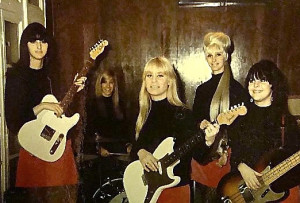 Formed in Grosse Pointe, Michigan, in 1964 by 17-year-old Patti Quatro, The Pleasure Seekers were born of Beatlemania and bred on Detroit muscle. The original lineup included Patti’s younger sister Suzi on bass, Diane Baker on piano, Nancy Ball on drums, and Mary Lou Ball on guitar. Eventually, the band became a true family affair when Arlene Quatro took over as pianist and sister Nancy stepped in as drummer.
Formed in Grosse Pointe, Michigan, in 1964 by 17-year-old Patti Quatro, The Pleasure Seekers were born of Beatlemania and bred on Detroit muscle. The original lineup included Patti’s younger sister Suzi on bass, Diane Baker on piano, Nancy Ball on drums, and Mary Lou Ball on guitar. Eventually, the band became a true family affair when Arlene Quatro took over as pianist and sister Nancy stepped in as drummer.
Within a year of forming, they signed a contract with Hideout Records and released their first single, “Never Thought You’d Leave Me” b/w “What a Way to Die.”
The Quatro girls came from a musical family that encouraged them to follow their rock dreams. Their brother Michael, a Detroit concert promoter, got them bookings in top local clubs and secured them spots as opening acts for up-and-coming artists.
“We started as teenagers,” Patti told Margaret Moser of The Austin Chronicle in 2011. “There were teen clubs like the Hideout everywhere in Michigan. Everybody wanted to have a girl band to bring in the boys to the clubs. We were on the road all the time. The girl bands were such an unusual thing that we got more bookings than Ted [Nugent] and all those Detroit guys. We got out real quick and toured all over.”
T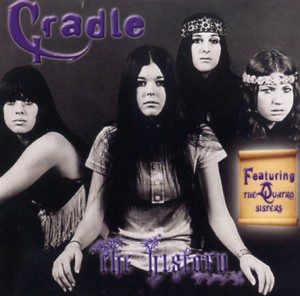 he Pleasure Seekers opened for people like Alice Cooper and Bob Seger, and even jammed with guitar great Jeff Beck, who became a mentor to Patti.
he Pleasure Seekers opened for people like Alice Cooper and Bob Seger, and even jammed with guitar great Jeff Beck, who became a mentor to Patti.
“We were trying to make it through the executives who wanted us to wear lavish costumes, like in Vegas or on The Partridge Family,” Patti told The Chronicle. “Wow the crowd – tits and ass. We weren’t having it. That was always the fight with the executives. They just didn’t know what to do with women. They were scared you’d fall in love and get married.”
In 1968, the Seekers signed with Mercury Records, released a second single, “Light of Love” (which charted), and toured the U.S. They played everything from original material to Beatles tunes to Motown hits, and were one of the first bands to feature light shows in their act.
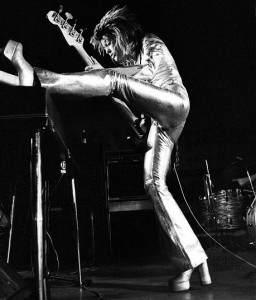 Seeking a harder edge, the band morphed into Cradle in 1969. They performed at pop and rock festivals and even toured Vietnam before disbanding in 1973.
Seeking a harder edge, the band morphed into Cradle in 1969. They performed at pop and rock festivals and even toured Vietnam before disbanding in 1973.
Patti went on to play with the 1970s all-female rock band Fanny for a while, and later managed Cradle Rock Publishing with sister Nancy. She currently runs a tour services company – Starlight Travel – that caters to rock artists and actors.
And then there’s Suzi, the Quatro sister who struck out on her own and put some major dents in the glass ceiling of rock and roll.
It’s a pity that many people remember her primarily for her role in the 1970s sitcom Happy Days – as guitarist Leather Tuscadero, younger sister of Fonzie’s girlfriend. Suzi is the genuine article. Decked out in her trademark leather jumpsuits and platform shoes, this 5-foot firecracker was the first true female singer/guitarist rock star – backed by an all-male band, no less! In 1975, she had the honor of being the first female electric guitarist ever featured on the oh-so-sacred cover of Rolling Stone magazine.
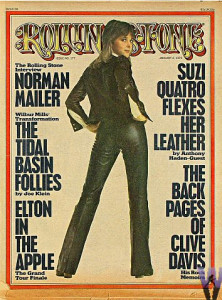 Suzi released a slew of singles that topped the charts in Europe and Australia, and has sold 50 million albums during her career. Although she never really broke big in her native America, she was a major influence on future female guitarists, from The Pretenders’ Chrissie Hynde to The Talking Heads’ Tina Weymouth. She’s acted on the London stage, has appeared in British TV shows like Absolutely Fabulous, and hosted rock and roll programs on BBC Radio. A rocker till the end, she still performs live around the world.
Suzi released a slew of singles that topped the charts in Europe and Australia, and has sold 50 million albums during her career. Although she never really broke big in her native America, she was a major influence on future female guitarists, from The Pretenders’ Chrissie Hynde to The Talking Heads’ Tina Weymouth. She’s acted on the London stage, has appeared in British TV shows like Absolutely Fabulous, and hosted rock and roll programs on BBC Radio. A rocker till the end, she still performs live around the world.
We’ll end with some wise words of advice from Patti Quatro to young women everywhere who seek pleasure as professional musicians: “Develop the thickest hide you can. And rock ’til you drop.”
Here are The Pleasure Seekers singing one of their most popular songs. This was before they ditched the glittery mini-dresses favored by the record label executives.
Here’s the harder-rocking Cradle:
And finally, check out the absolutely fabulous Suzi Quatro, performing her biggest hit “Can the Can” in 1973 with her all-boy backup band!
© Dana Spiardi, May 2, 2014
]]>
Here’s the first in a series of articles showcasing the electric girl groups you’ve probably never heard of.
It could only happen in America: In 1947, a 7-year-old Polish-Jewish girl named Genyusha “Genya” Zelkovicz arrived in New York City’s Lower East Side with her parents and a sister, speaking not a word of English. They were the only ones in their family to survive the Holocaust. Genya’s mother nicknamed her Goldie, and thus began her Americanization.
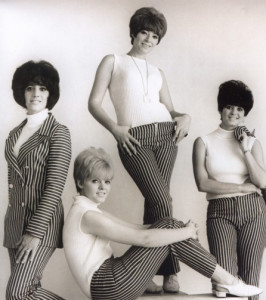 In 1962, she attended a Brooklyn club called The Lollipop Lounge, where, on a dare, she took the stage and sang a song with a group of college kids who called themselves The Escorts. The band’s bass singer (and future ’70s super-producer) Richard Perry liked what he heard and invited her to join the outfit. They found steady work in the New York clubs and enjoyed some regional success with a cover of West Side Story’s “Somewhere.” When Goldie discovered Ginger Bianco playing drums in a Greenwich Village bar, she got the idea to form an all-girl band. They combined their names and became Goldie and the Gingerbreads.
In 1962, she attended a Brooklyn club called The Lollipop Lounge, where, on a dare, she took the stage and sang a song with a group of college kids who called themselves The Escorts. The band’s bass singer (and future ’70s super-producer) Richard Perry liked what he heard and invited her to join the outfit. They found steady work in the New York clubs and enjoyed some regional success with a cover of West Side Story’s “Somewhere.” When Goldie discovered Ginger Bianco playing drums in a Greenwich Village bar, she got the idea to form an all-girl band. They combined their names and became Goldie and the Gingerbreads.
With the addition of pianist Carol O’Grady, the trio toured West Germany and Switzerland with Chubby Checker in 1962. Afterwards, they hired guitarist/vocalist Carol MacDonald, and replaced O’Grady with Margo Lewis. The lineup was complete. Decca Records signed the group in 1963, making them the first female band to land a record deal from a major label. And yes, they had to pose cheesecake-style in glittery garb for publicity purposes.
In 1964, Goldie and girls were hired to provide entertainment at a mod New York party for Warhol discovery Baby Jane Holzer. Guests, including The Rolling Stones and Atlantic Records founder Ahmet Ertegün, were suitably impressed. Ertegün wooed the group from Decca and signed them to Atlantic’s subsidiary label, Atco.
![Goldie and the Gingerbreads on bill with the Rolling Stones. [The Hip Quotient] Screen Shot 2015-08-22 at 3.40.33 PM](http://hipquotient.com/wp-content/uploads/2015/03/Screen-Shot-2015-08-22-at-3.40.33-PM-206x300.jpg) When British Invasion band The Animals caught the Gingerbreads’ act at the The Wagon Wheel club in Times Square, their manager invited them to tour England. Thus began a successful two-year run, as the girls toured non-stop on bills that included The Beatles, The Stones, The Animals, The Kinks, Manfred Mann, The Yardbirds, and The Hollies. (You can just imagine what went on in those tour buses.)
When British Invasion band The Animals caught the Gingerbreads’ act at the The Wagon Wheel club in Times Square, their manager invited them to tour England. Thus began a successful two-year run, as the girls toured non-stop on bills that included The Beatles, The Stones, The Animals, The Kinks, Manfred Mann, The Yardbirds, and The Hollies. (You can just imagine what went on in those tour buses.)
Following in the footsteps of their male British counterparts, they played numerous gigs in West Germany, even appearing at The Beatles’ early haunt, The Star Club in Hamburg. It turns out that Ringo himself was a fan. In 1965 he managed to get them a spot on the popular BBC variety show Not Only….But Also, hosted by Dudley Moore and Peter Cook. They sang the song that should have put them on the map: “Can’t You Hear My Heartbeat.” But the high-profile Herman’s Hermits beat them to the punch, releasing their own hit version of the song two weeks earlier. The Gingerbreads’ release reached #25 in the U.K., but bombed in the U.S.
The band eventually returned to America, but failed to make an impact. Some say Goldie’s overbearing leadership style precipitated their demise. But the girls’ frustration over their inability to sell records likely contributed to their frustration and ultimate breakup in 1968.
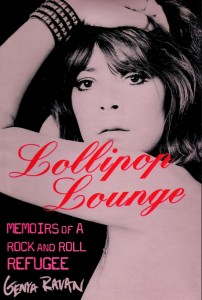 All of the band members stayed active in the music business. Bianco and MacDonald formed the jazz-fusion band Isis. Lewis toured as a keyboardist with Bo Diddley and currently runs her own talent consulting company. But it’s Goldie Zelkovicz who’s managed to carve out a real niche for herself in the rock world. As Genya Ravan she fronted her own jazz-fusion band, Ten Wheel Drive, from 1968 through 1974. She’s appeared on TV talk shows, produced The Dead Boys’ debut LP and a comeback album for Ronnie Spector, served as head of production at CBGB Records, and currently hosts two Sirius/XM radio shows: Goldie’s Garage and Chicks and Broads. Her 2004 memoir Lollipop Lounge: Memoirs of a Rock and Roll Refugee takes the reader on a wild ride – from her prison camp days in Poland to her struggles with alcohol and cancer. Hey Genya, there’s still time to roll a Harley down the halls of a Hyatt!
All of the band members stayed active in the music business. Bianco and MacDonald formed the jazz-fusion band Isis. Lewis toured as a keyboardist with Bo Diddley and currently runs her own talent consulting company. But it’s Goldie Zelkovicz who’s managed to carve out a real niche for herself in the rock world. As Genya Ravan she fronted her own jazz-fusion band, Ten Wheel Drive, from 1968 through 1974. She’s appeared on TV talk shows, produced The Dead Boys’ debut LP and a comeback album for Ronnie Spector, served as head of production at CBGB Records, and currently hosts two Sirius/XM radio shows: Goldie’s Garage and Chicks and Broads. Her 2004 memoir Lollipop Lounge: Memoirs of a Rock and Roll Refugee takes the reader on a wild ride – from her prison camp days in Poland to her struggles with alcohol and cancer. Hey Genya, there’s still time to roll a Harley down the halls of a Hyatt!
So, do Goldie and the Gingerbreads qualify as Rock and Roll Hall of Fame inductees? Based on their limited body of work, probably not. But as the first all-female guitar band, and the first to be signed by a major label…well, why not? (I mean, Kiss got in, after all!) In 2011 the Hall of Fame acknowledged their contributions by including the group in its traveling “Women in Music” exhibit.
Perhaps a more meaningful honor was one bestowed upon them by the Women in Music organization, which presented the first ladies of rock with a Touchstone Award. It’s given annually to women who possess “the courage and inspiration to make a difference in the music industry and whose work has set new standards.” And it’s only fitting that one of the band’s earliest supporters, the legendary Ahmet Ertegün, presented them with their statuettes.
Here are The Gingerbreads on British television, circa 1965:
And here’s the great Genya Ravan, still ravin’, in 2013:
© Dana Spiardi, April 18, 2014
]]>Now, if you’re old enough to get that Bugs-Daffy cartoon reference, you’re no doubt old enough to remember a song that today would be considered a “women’s power” anthem: Nancy Sinatra’s “These Boots are Made for Walkin’, which hit the #1 spot on the Billboard charts in January1966. With it’s slinky guitar strut and finger-pointing tough girl lyrics, it quickly became a favorite among my growing collection of 45s. What a way for a six-year-old to learn the fine art of insult and accusation!
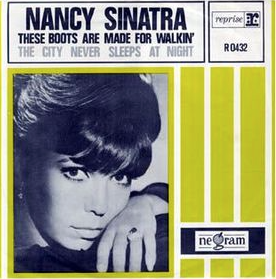 You keep lying, when you oughta be truthin’.
You keep lying, when you oughta be truthin’.
And you keep losin’, when you oughta not bet.
You keep samin’, when you oughta be a-changin’.
Now what’s right is right, but you ain’t been right yet.
These boots are made for walkin’. And that’s just what they’ll do.
One of these days these boots are gonna walk all over you.
As I sat in my room, watching the record player’s needle skate so nicely along the grooves of the little vinyl disc, I wondered: “Would I ever be angry enough at a boy to tell him off like this?” “Would I ever have the occasion to use such interesting language?” All in due time, all in due time.
And would I ever be mature enough to wear boots like the red ones Nancy wore on the cover of the record sleeve? No, I would never reach an adequate level of maturity. But that didn’t stop my fab mom from buying me my first pair of white mini go-gos soon after the song’s release kicked-off a national boot craze. First-graders in go-go boots? Well, it was the swinging ’60s after all. (A year later Mrs. Lore sent me to the principal’s office for wearing lilac-colored fishnet stockings to school. Hey, could I help it if Mommy followed Chrissie Shrimpton and Twiggy?)
 For a few years in the psychedelic ’60s, Nancy Sinatra was as fab as her famous father Frank was considered square by the hippies. She released a string of hit records, appeared in TV shows and starred with Elvis in one of his silly formula movies, “Speedway.” Even the young Material Girl was a Nancy fan. “Nancy Sinatra was a huge influence on me,” said Madonna. “I wanted to put on my go-go boots and walk all over someone.” (And she’s done just THAT, alright!)
For a few years in the psychedelic ’60s, Nancy Sinatra was as fab as her famous father Frank was considered square by the hippies. She released a string of hit records, appeared in TV shows and starred with Elvis in one of his silly formula movies, “Speedway.” Even the young Material Girl was a Nancy fan. “Nancy Sinatra was a huge influence on me,” said Madonna. “I wanted to put on my go-go boots and walk all over someone.” (And she’s done just THAT, alright!)
Nancy’s classic put-down song was written by Lee Hazlewood, who penned many of her hits, produced her records and occasionally sang with her, duet-style. It was recorded using the top studio musicians of the day: legendary “Wrecking Crew” members Hal Blaine on drums; Al Casey, Tommy Tedesco, and Billy Strange on guitars; Ollie Mitchell, Roy Caton and Lew McCreary on horns; and Carol Kaye on electric bass. The defining funky bass line was the work of Chuck Berghofer. “Boots” sold over a million copies and was nominated for three Grammy awards. It’s been covered by Geri Halliwell, Megadeth, Jessica Simpson, Lil’ Kim, Billy Ray Cyrus, Faster Pussycat, and The Supremes.
By the mid-1970s Nancy Sinatra would nearly disappear from the music scene, as singers like Laura Nyro, Joni Mitchell, Carly Simon, and Carole King gained fame for their songwriting skills and earthier material. But she’ll always occupy a special place in my pantheon of girl rockers. Her music entertained me at a time when I was too green for Grace Slick and too cool for Connie Francis. And thanks to her cry-tough song, I’ve spent my life knee-deep in a boot bonanza.
Oh, how I wanted to use “Little Boots” as my nom de plume, but some British poptart had already taken it as her stage name. Maybe it’s just as well. It is, after all, the English translation of Caligula, the nickname of Rome’s most monstrous emperor, Gaius. Oh, we excitable Italians and our footwear!
Here’s Nancy struttin’ her stuff. To me at age 6, this TV clip was the height of groovy. Ooh, I just found me a brand new box of matches!
© Dana Spiardi, Jan 28, 2012 (original publication date)
 “One of the most important female bands in American rock has been buried without a trace…They were one of the finest… rock bands of their time, in about 1973. They were extraordinary: They wrote everything, they played like motherf**kers, they were just colossal and wonderful. They’re as important as anybody else who’s ever been, ever; it just wasn’t their time. Revivify Fanny. And I will feel that my work is done.”
“One of the most important female bands in American rock has been buried without a trace…They were one of the finest… rock bands of their time, in about 1973. They were extraordinary: They wrote everything, they played like motherf**kers, they were just colossal and wonderful. They’re as important as anybody else who’s ever been, ever; it just wasn’t their time. Revivify Fanny. And I will feel that my work is done.”
Okay, Mr. Bowie, here’s my contribution to revivifying the band.
In the early ’60s, June and Jean Millington moved to Sacramento from their birthplace of Manila in the Philippines. Their mother was a Filipina socialite; their father a U.S. Navy Lt. Commander. The sisters formed an all-girl band, The Svelts, while still in high school. Following several personnel changes, the band morphed into Wild Honey and enjoyed some success at L.A.’s famous Troubadour Club. That’s where they caught the eye of producer Richard Perry, who took a particular interest in June and Jean and helped their reconfigured group, Fanny, snag a deal with Warner Brothers’ Reprise label (the one formed by Frank Sinatra!).
The sisters said they named the group Fanny to denote “the female spirit.” I guess it was the “spirit” of earlier times, when “Fanny” was a slightly cheeky pet name for Frances. Bassist/lead vocalist Jean and guitarist June, together with drummer Alice de Buhr and keyboardist Nickey Barclay, released four albums between 1970 and 1973: “Fanny,” “Charity Ball,” “Fanny Hill” (the name of Cleland’s erotic novel), and “Mother’s Pride.” Their 1971 single “Charity Ball” reached #40 on the charts.
 The band toured with the likes of Humble Pie, Jethro Tull and Slade — all British acts. In fact, Fanny, like so many other all-girl groups, was more popular in the U.K. than back home.
The band toured with the likes of Humble Pie, Jethro Tull and Slade — all British acts. In fact, Fanny, like so many other all-girl groups, was more popular in the U.K. than back home.
When June (once described by Guitar Player magazine as the hottest female guitar player in the music industry) and Alice left the group around 1974, the remaining members were joined by guitarist Patti Quatro (founder of the pioneering femme band The Pleasure Seekers) and drummer Brie Brandt. The restructured Fanny released one final LP, “Rock and Roll Survivors.” The album spawned “Butter Boy,” a single that reached #29 on Billboard’s Hot 100 in April 1975.
And that pretty much marked the apex of Fanny’s time as an almost-famous rock band. After their breakup, Patti and Brie went on to record and tour as solo artists with performers like Jimmy Buffet, Electric Light Orchestra, Keith Moon and Carole King. The Millington sisters kept active in the music business, playing as Fanny from time to time. In 2011, they released the album “Play Like a Girl” on June’s label Fabulous Records.
I love the irony in the title of that album. If girls are supposed to “play nice” by rock-society’s standards, then these ladies broke all the rules. To re-quote David Bowie, “they played like motherf**kers.”
This clip shows Fanny at their best, with Jean belting out “Special Care.”
“Butter Boy” was the group’s highest-charting hit. This Fanny lineup includes the great Patti Quatro on guitar.
Here they are performing one of their own compositions, “You’re the One.”
© Dana Spiardi, June 2, 2014
]]>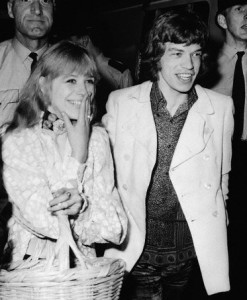 Marianne’s signature song, “As Tears Go By,” was the first original composition written by Jagger and fellow Rolling Stone Keith Richards. She inspired numerous Stones’ classics, including “Wild Horses,” “You Can’t Always Get What You Want,” “I Got the Blues,” and “Sister Morphine” (a song she most likely composed). She set the spark for “Sympathy for the Devil,” which Mick wrote after reading her copy of the famous Bulgakov satire “The Master and Margarita.” She’s disguised as “Carrie Anne” in the Graham Nash-penned Hollies tune and is the bird of the Beatles’ song “And Your Bird Can Sing.” But despite her aristocratic roots and her queenly position among the rock royalty of the day, life would never be easy or ordinary for Marianne Faithfull.
Marianne’s signature song, “As Tears Go By,” was the first original composition written by Jagger and fellow Rolling Stone Keith Richards. She inspired numerous Stones’ classics, including “Wild Horses,” “You Can’t Always Get What You Want,” “I Got the Blues,” and “Sister Morphine” (a song she most likely composed). She set the spark for “Sympathy for the Devil,” which Mick wrote after reading her copy of the famous Bulgakov satire “The Master and Margarita.” She’s disguised as “Carrie Anne” in the Graham Nash-penned Hollies tune and is the bird of the Beatles’ song “And Your Bird Can Sing.” But despite her aristocratic roots and her queenly position among the rock royalty of the day, life would never be easy or ordinary for Marianne Faithfull.
She was the daughter of divorced parents: a British, bohemian-styled psychology professor father and a baroness mother, the Viennese-born Eva von Sacher-Masoch, whose great uncle Leopold von Sacher-Masoch wrote Venus in Furs, the novel that spawned the word masochism. How fitting that Marianne would end up living a life nearly destroyed by masochism.
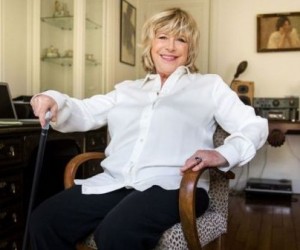 She was the center of controversy, rumored to be wrapped in nothing but a fur rug as Mick nibbled on a Mars Bar lodged in her vagina (one of the greatest urban myths in rock history) at the moment the police stormed Keith Richards’ house to conduct a drug search in 1966. “It destroyed me,” she said of this incident. “To be a male drug addict and to act like that is always enhancing and glamorizing. A woman in that situation becomes a slut and a bad mother.”
She was the center of controversy, rumored to be wrapped in nothing but a fur rug as Mick nibbled on a Mars Bar lodged in her vagina (one of the greatest urban myths in rock history) at the moment the police stormed Keith Richards’ house to conduct a drug search in 1966. “It destroyed me,” she said of this incident. “To be a male drug addict and to act like that is always enhancing and glamorizing. A woman in that situation becomes a slut and a bad mother.”
And what do we make of that famous quote about having slept with all the Stones before settling on Mick as her springboard to fame? In her memoir, she explains that she was fed up with being portrayed in the media as a “ruthless adventuress,” and decided to manipulate this stuff to her own advantage. “It was somewhat of a perverse thing to do, but fun,” she said. (And in reality, Keith was the only Stone with whom she liaised, pre- and post-Mick!)
She lived through it all – chemical addiction, suicide attempts, homelessness, tuberculosis, anorexia, a miscarriage, and persecution by the press – and has emerged a brave, sober non-conformist whose timeworn voice can still rattle your bones. Faithfull is my favorite book about a woman’s rough ride through the rock jungle of the swinging sixties and toxic seventies.
Thanks, Marianne, for your courage and inspiration.
Here she is, singing a gorgeous Harry Nilsson song:
© Dana Spiardi, Dec 29, 2014
]]>